How to Make Low-Carb Pasta in Under 7 Minutes
By Adam Brown
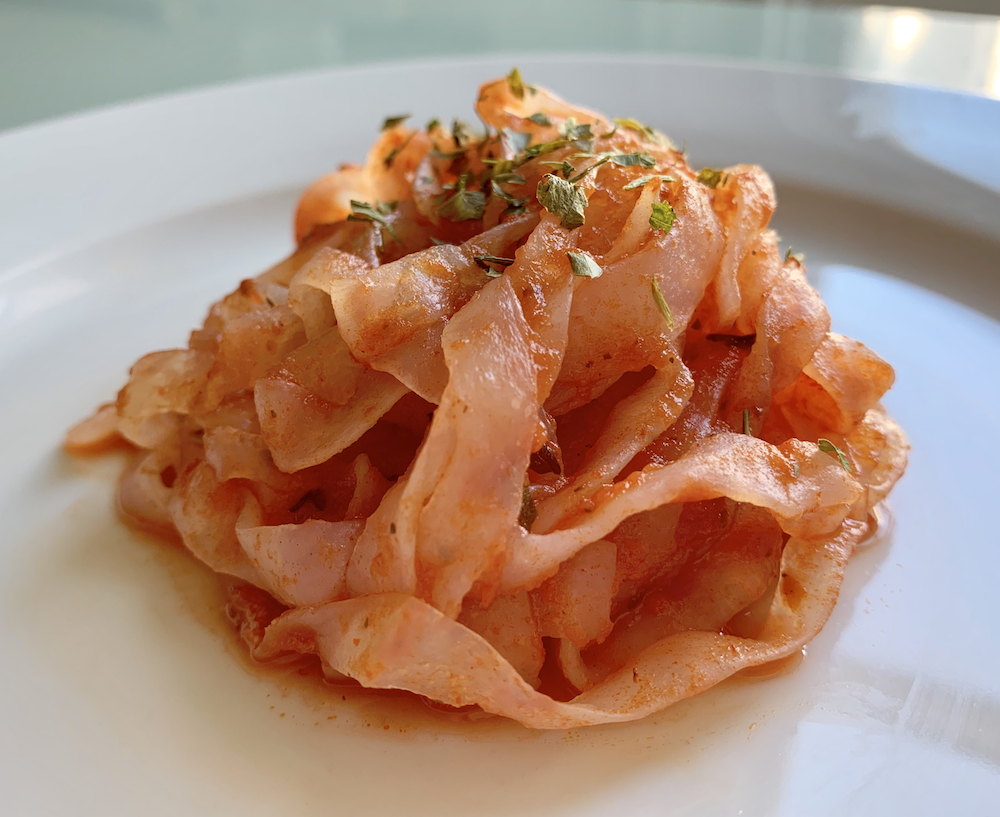 By Adam Brown
By Adam Brown
The diabetes magic of using shirataki noodles for pasta, ramen, soup, and more. Finally, low-carb noodles that actually taste great and have a small impact on blood sugar!
I am a recovering pastaholic.
As a teenager with diabetes, I could eat mountains of spaghetti, easily consuming over 150 grams of carbs at one time – far more than I eat in a day now. When I got on CGM and began eating low-carb about ten years ago, I chose to give up pasta – the blood sugar benefits and diabetes simplicity outweighed my love for eating noodles.
Over the years, I have tinkered with various low-carb pasta hacks, including kelp noodles and spiralized zucchini (“zoodles”). These were slightly better than no noodles at all, but have limitations – they require too much prep time and don’t have the texture of pasta.
About a year ago, a few friends told me about “shirataki noodles” – a remarkable low-carb noodle that actually does taste like pasta and takes less than seven minutes to make. They have now become a near-once-weekly staple in my diet.
Shirataki noodles are made from the root of an Asian plant (konjac), and each single-person serving has about 5-6 grams of carbs. Importantly, 100% of the carbs are from soluble fiber, translating to little impact on blood sugar.
.png) I’ve tried two brands – Skinny Noodles and Miracle Noodles – and I buy the former in a 12-pack case from Amazon. Many natural and Asian grocery stores also stock shirataki noodles. At about $2.50 per serving, shirataki noodles are more expensive than normal pasta. Still, relative to cutting out pasta and noodles entirely, these are a welcome addition to the low-carb toolbox. (For those with celiac, they are also gluten free.)
I’ve tried two brands – Skinny Noodles and Miracle Noodles – and I buy the former in a 12-pack case from Amazon. Many natural and Asian grocery stores also stock shirataki noodles. At about $2.50 per serving, shirataki noodles are more expensive than normal pasta. Still, relative to cutting out pasta and noodles entirely, these are a welcome addition to the low-carb toolbox. (For those with celiac, they are also gluten free.)
I have a high bar for packaged foods – I look for less than five ingredients on the label, less than 20 grams of carbs per serving, most of the carbs from fiber, and no sugar. Shirataki noodles meet that bar! Plus, I love that they can be stored in the pantry – I often make them when there is no fresh food in my fridge.
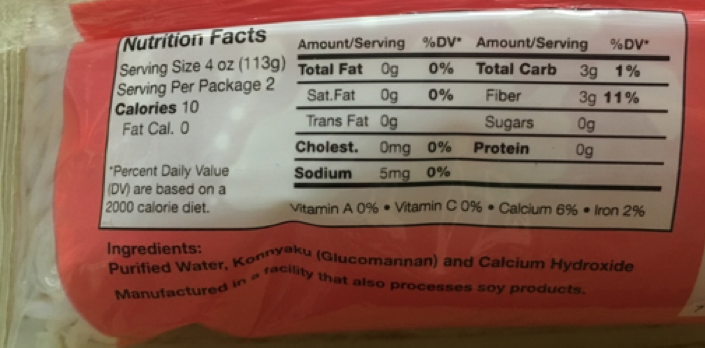
How to Make Low-Carb Noodles In Under 7 Minutes
Shirataki noodles come in a single-serving package (see above) that contains some water.
-
Open the package, pour the noodles into a strainer, and rinse them under water for one minute.
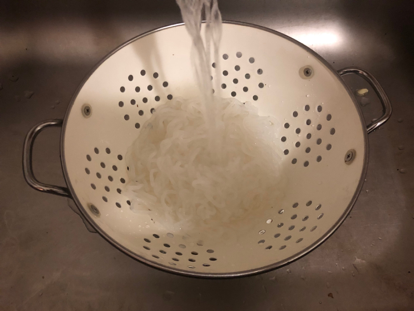
-
Boil two cups of water in a small pot (or electric kettle).
-
Cook the noodles in a pot of boiling water for 2 minutes.

-
Move the now-boiled noodles back to the strainer, shaking out the hot water.

-
Dry the noodles in a hot, non-oiled pan for one minute.

Once cooked, shirataki noodles are extremely versatile. We’ve made low-carb spaghetti, low-carb ramen, and low-carb noodle soups. The pictures below are from my kitchen table – they are clearly not restaurant or cookbook quality, but I promise the taste is awesome.
I take about 1.5 units of insulin to cover the meals below, equivalent to about 15 grams of carbs.
To make spaghetti, stir in pesto or red sauce to the cooked noodles. (We use about 2 tbsp of pesto or about ¼ cup of red sauce.) Add parmesan cheese to finish it! For an extra-filling meal, we add sautéed ground beef or vegetables, chicken sausage, or almond-flour-breaded chicken tenders (low-carb chicken parmesan!).

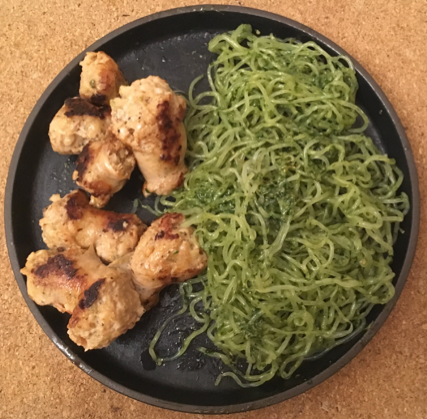
To make ramen, add the cooked noodles to a homemade ramen broth: 2-3 cups of boiling water, 1 tbsp of Better-Than-Bouillon paste (chicken flavor), 1 tbsp of Red Miso paste, soy sauce (to taste), Sriracha (to taste). Pour the broth into a bowl with the cooked noodles, and then add any toppings you like. We like toasted sesame seeds, seaweed, an egg (we like soft-boiled), green onion, and cilantro.
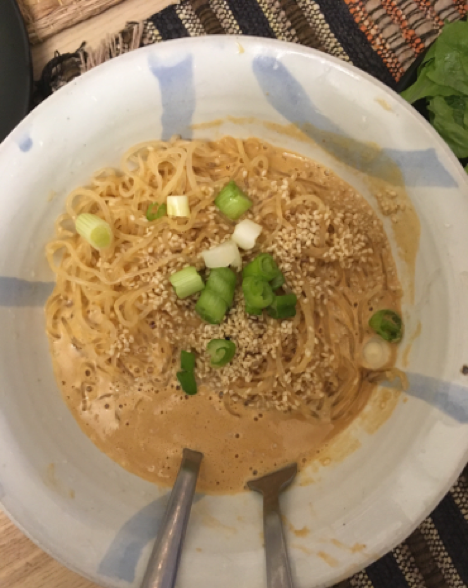

To make a basic noodle soup, add the cooked noodles to a homemade or store-bought broth of your choice. To make it a heartier soup, add chicken, shrimp, and/or vegetables.
Note: diaTribe has never received any compensation from the products mentioned in this column and is not in touch with the companies; Adam just uses them and really likes them.
You might also like: How to Make Low-Carb Waffles in Under 7 Minutes.
Please send questions and feedback here.
.jpg) Over 100,000 copies of Bright Spots & Landmines: The Diabetes Guide I Wish Someone Had Handed Me have been sold/downloaded! Get it as a…
Over 100,000 copies of Bright Spots & Landmines: The Diabetes Guide I Wish Someone Had Handed Me have been sold/downloaded! Get it as a…
- Free PDF download or buy it on Amazon in paperback ($6) or Kindle ($1.99)
- Free audiobook on diaTribe or YouTube, or buy it at Audible, Amazon, iTunes
- mmol/L version: free PDF and in paperback at Amazon UK and Amazon Canada







